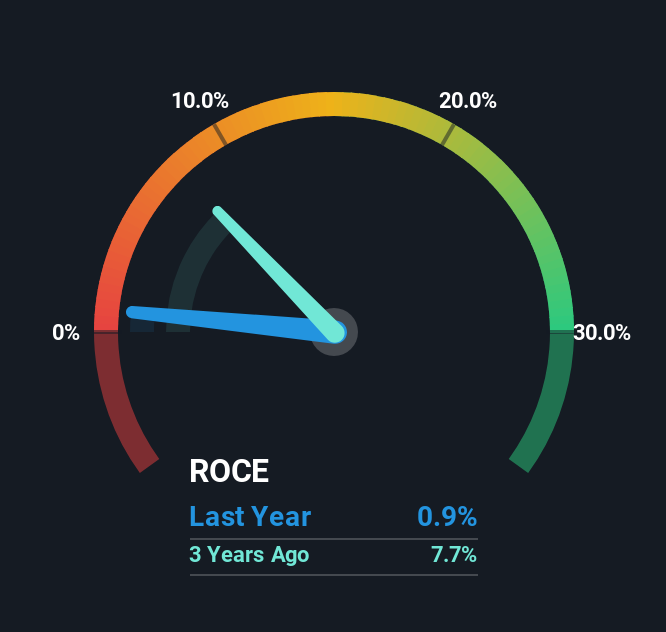- Japan
- /
- Electronic Equipment and Components
- /
- TSE:6999
There Are Reasons To Feel Uneasy About KOA's (TSE:6999) Returns On Capital
If you're looking for a multi-bagger, there's a few things to keep an eye out for. Typically, we'll want to notice a trend of growing return on capital employed (ROCE) and alongside that, an expanding base of capital employed. Put simply, these types of businesses are compounding machines, meaning they are continually reinvesting their earnings at ever-higher rates of return. Although, when we looked at KOA (TSE:6999), it didn't seem to tick all of these boxes.
What Is Return On Capital Employed (ROCE)?
For those that aren't sure what ROCE is, it measures the amount of pre-tax profits a company can generate from the capital employed in its business. The formula for this calculation on KOA is:
Return on Capital Employed = Earnings Before Interest and Tax (EBIT) ÷ (Total Assets - Current Liabilities)
0.0094 = JP¥1.2b ÷ (JP¥141b - JP¥16b) (Based on the trailing twelve months to March 2025).
Therefore, KOA has an ROCE of 0.9%. In absolute terms, that's a low return and it also under-performs the Electronic industry average of 9.2%.
Check out our latest analysis for KOA

In the above chart we have measured KOA's prior ROCE against its prior performance, but the future is arguably more important. If you're interested, you can view the analysts predictions in our free analyst report for KOA .
The Trend Of ROCE
In terms of KOA's historical ROCE movements, the trend isn't fantastic. Around five years ago the returns on capital were 2.2%, but since then they've fallen to 0.9%. Meanwhile, the business is utilizing more capital but this hasn't moved the needle much in terms of sales in the past 12 months, so this could reflect longer term investments. It may take some time before the company starts to see any change in earnings from these investments.
What We Can Learn From KOA's ROCE
To conclude, we've found that KOA is reinvesting in the business, but returns have been falling. And with the stock having returned a mere 20% in the last five years to shareholders, you could argue that they're aware of these lackluster trends. So if you're looking for a multi-bagger, the underlying trends indicate you may have better chances elsewhere.
On a final note, we found 4 warning signs for KOA (2 make us uncomfortable) you should be aware of.
While KOA isn't earning the highest return, check out this free list of companies that are earning high returns on equity with solid balance sheets.
Valuation is complex, but we're here to simplify it.
Discover if KOA might be undervalued or overvalued with our detailed analysis, featuring fair value estimates, potential risks, dividends, insider trades, and its financial condition.
Access Free AnalysisHave feedback on this article? Concerned about the content? Get in touch with us directly. Alternatively, email editorial-team (at) simplywallst.com.
This article by Simply Wall St is general in nature. We provide commentary based on historical data and analyst forecasts only using an unbiased methodology and our articles are not intended to be financial advice. It does not constitute a recommendation to buy or sell any stock, and does not take account of your objectives, or your financial situation. We aim to bring you long-term focused analysis driven by fundamental data. Note that our analysis may not factor in the latest price-sensitive company announcements or qualitative material. Simply Wall St has no position in any stocks mentioned.
About TSE:6999
KOA
Develops, manufactures, and sells circuit components in Japan, Asia, America, and Europe.
Excellent balance sheet with reasonable growth potential.
Similar Companies
Market Insights
Community Narratives



